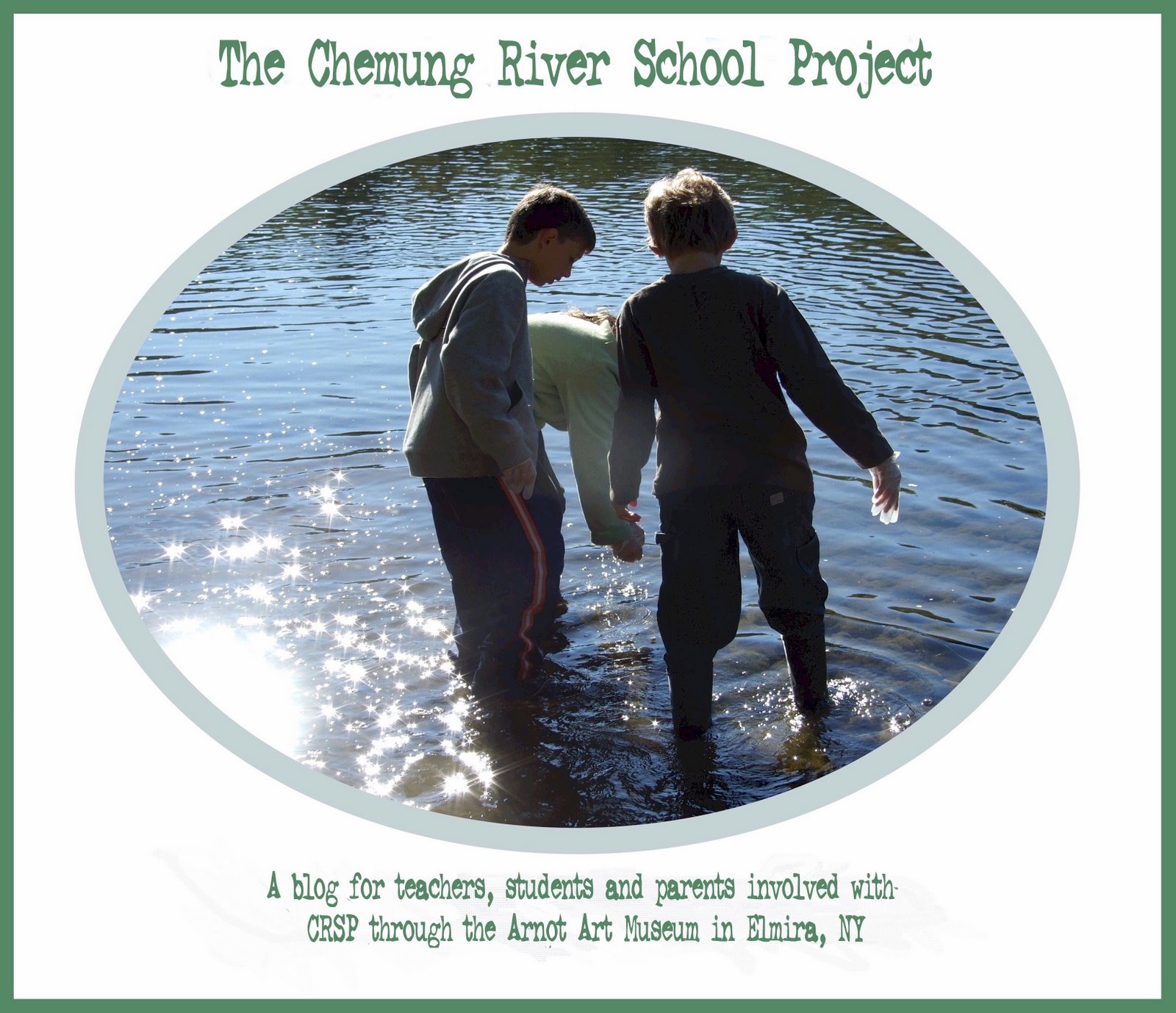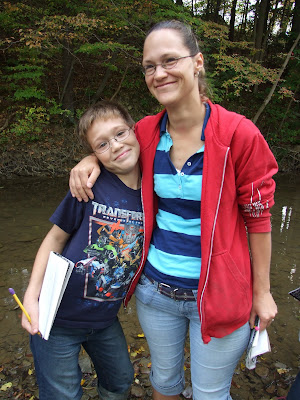Students at Gardner Road Elementary School were given follow-up sheets for their experience with visiting artists, Diedra Krieger and Damali Abrams. Below are the answers (in red font), along with a review of the program. Keep in mind that in art, the "answers" can be questioned! Indeed, we hope our programs encourage and help develop critical thinking and divergent thinking skills. We always encourage questions that can be backed up with sound reasoning.

Thomas Cole,
Autumn in the Catskills 1827, oil on panel
solitary artist, activist art, two-dimensional media, landscape, Hudson River School of Art Students in the Chemung River School Project were treated to an intensive introduction to the work of the Hudson River School artists in November by artist/teacher, Janna Keser at the Arnot Art Museum (see blog post below entitled
November tours at the Arnot Art Museum). The museum has considerable holdings of representational art from various countries and eras in history including a significant collection of Hudson River School art. During this session, students learned that the Hudson River School artists who painted nearly 200 years ago, were ACTIVISTS as well as painters. Their paintings depicted nature in such as way that people began to feel the land was worthy of protection; thus, the work they did was instrumental in establishing our first national parks! Artists frequently hope their art works to make the world a better place. The November tour at the Arnot introduced students to art that was just part of a long continuum of activist art that has existed from the moment human-beings have held implements for drawing in their hands. Diedra and Damali continue the tradition of art and activism, but, as Gardner students have seen, the forms their art takes considerably departs from their Hudson River School predecessors. Through the follow-up exercise, it is hoped that students consider both the similarities and differences.

Diedra Krieger,
Plastic Fantastic, installation, 2008
collaboration, activist art, installation, performance art, digital media, contemporary art
While the Hudson River School artists were solitary painters and their art may still fit the popular conception of what an artist does – paint landscapes or portraits or still-lifes alone in their studios or in the field (and many contemporary artists do), the work of many other contemporary artists does not in any way resemble the work of their predecessors. Artists today not only paint on canvas, but utilize a wide variety of materials to create sculptures, installations, video and performance art among many other forms. Many also work collaboratively, as do our visiting artists, Diedra and Damali. As with the Hudson River School artists, however, many of today's artists still intend for their art to make the world a better place. Diedra Krieger's geodesic dome as inspired by the inventor of the dome, Buckminster Fuller,* was made using over 4,000 post-consumer water bottles. (It was, in her words, a "nomadic, immersive environment." Diedra wanted it to be "a site unlike any room or space one may frequent....It is the site of an integrated program of events, including the making of the environment, music events, a video shoot, interviews, education, activism, social gatherings, and performance. The overwhelming use of materials function not just as an aesthetic but as a strategy to raise awareness and criticality about the everyday and the basic right to water." As Diedra and Damali stressed to Gardner Road students, their artwork is both collaborative and activist at the same time.

Diedra Krieger with camera at Gardner Road Elementary School
collaboration, activism, digital media, performance art, contemporary art
Diedra's dome is the site of video-shoots as well as the site where the videos can be viewed. Of course, the Hudson River School artists did not have access to the sophisticated technology used to create digital art, but if you frequent galleries and museums today - especially in large cities, a good share of the art work you see is digital or in the form of installation. At Gardner Road, students were able to witness part of Diedra's process as well as that of Damali Abrams. They watched performances via video by the artists, and then collaboratively improvised their own performances and created their own videos. They also made posters which contained messages about conservation and served as "commercials" for their videos - just as the artists have done. For this experience, the process was much more important than the product. For the Birds Too
For the Birds Too - an interactive installation of multiple "flying" bird sculptures at the Rathbone Gallery, The Sage Collegs, Albany, NY, October 8 - November 10, 1998.
collaboration, digital media, performance art, contemporary art
This is an example of work that can be found in the galleries of today. http://www.janeingramallen.com/Janeweb-birdstatement/Sage/sage.htm
 solitary artist, activist art, collaboration, close-up, performance artist, contemporary art
solitary artist, activist art, collaboration, close-up, performance artist, contemporary art
Damali Abrams is a multi-disciplinary artist who sometimes works alone and sometimes works with others. She is a performance artist, but, like Diedra, she also creates installations and does two-dimensional artwork. Among other interests, Damali is concerned with health and nutrition, self-esteem of children, literacy and increasing awareness of issues pertaining to race, gender and class. Gardner Road students were inspired by her video-art and learned about healthy habits as they did so!

Esther Nisenthal Krinitz, Swimming in the River, needlework and fabric collage
solitary artist, activist art, textile, two-dimensional media, landscape, contemporary art
In November, students of CRSP were also privileged to view a few works from a temporary exhibition of art by Holocaust Survivor, Esther Nisenthal Krinitz called "Fabric of Survival."
Esther Nisenthal Krinitz, along with her sister Mania, were the only members of their family, and among the few Jews in their Polish village, to survive the Holocaust....In 1977, at the age of 50, Esther Nisenthal Krinitz began creating works of fabric art to depict her stories of survival. Over a 20-year period she created a collection of 36 needlework and fabric collage pictures which are now on public exhibition. http://www.artandremembrance.org/
Krinitz' work is two-dimensional, but stands out in stark contrast to other works in the permanent collection at the museum. Krinitz' work was not created using paint on canvas, but her needle and thread. "Swimming in the River" depicts a happy time in Krinitz' young life - before the Nazi invasion. Next week, Center Street students will be studying with another artist who makes textile art (among other things) - Annemarie Zwack.

activist art, collaboration, close-up, digital media, performance art, contemporary art
Gardner Road Students watch their performances on video during class for the first time.
 War against War
War against War by Kathe Kollwitz
solitary artist, activist art, two-dimensional media,
As with "For the Birds, Too," and "Live Wire," Kollwitz' art is not work we looked at, but is a good example of activist art by a woman who is not a contemporary artist. She created her drawings and prints about 90 years ago. She was the only woman who painted at the same time as a group of artists we now call the German Expressionists. Her art was a way to express her grief, her anger, and her frustrations during World War I.
 Alice Walker Speaks the Truth, Annemarie Zwack, quilt
Alice Walker Speaks the Truth, Annemarie Zwack, quilt
solitary artist, activist art, textile, two-dimensional media, contemporary art
Annemarie Zwack is one of our teaching artists who is visiting the schools for the Chemung River School project. She will be working with students at Center Street Elementary School in Horseheads starting Monday, January 26th. Like Esther Nisenthal Krinitz, Annemarie works with textiles. However, Krinitz did embroidery and needlework to create tapestry-like works, while Annemarie makes quilts. In addition to textile art, Ms. Zwack also paints, draws and works with a variety of mixed-media. To learn more about her, see her post on this blog called
Annemarie Zwack joins Diedra Krieger and Damali Abrams in January wide-angle
wide-angle
Miss Shutter, teacher extraordinaire, surrounded by her students during Diedra and Damali's program last week.

Miss Shutter close-up!
Thank you, Miss Shutter - and to all the teachers and staff at Gardner Road - Principal, Mrs. Lisa Kelly, 4th grade teachers, Mrs. Setzer, Mrs. Shutter and Mrs. Bates - for helping Diedra and Damali to create a memorable and enriching experience for the 4th grade students at Gardner Road!
*About the dymaxion map invented by Buckminster Fuller

Buckminster Fuller was the inventor of the geodesic dome and the dymaxion map. Students at Gardner Road were introduced to both during Diedra and Damali's program. They were given copies of two dimensional dymaxion maps and learned how to assemble them into globes. Fuller found existing flat maps to grossly distort the size and proportions of land and water masses. He found a way to stay true to proportions in replicating a spherical map (the globe) on a flat, two-dimensional surface. To learn more about Fuller and his ingenious ideas and inventions, go to
http://inventors.about.com/od/dstartinventions/a/domes.htm

















 The students are eager to pay attention to the environment with all their senses. They will write about their experiences in their journals.
The students are eager to pay attention to the environment with all their senses. They will write about their experiences in their journals.



















 In the photograph above, Amy Karastury and her students engage in activities revolving around the Scholastics exhibition.
In the photograph above, Amy Karastury and her students engage in activities revolving around the Scholastics exhibition. 













